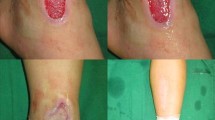Summary
In an attempt to obtain better function and appearance minimize blood loss and increase graft survival with minimal postoperative care, deep burns are treated by applying the fibrin glue to difficult recipient sites. A two-component fibrin sealant is used, fibrinogen made from pooled human plasma and bovine thrombin (Tissucol, Immuno AG, Vienna, Austria). The fibrin sealant is described as well as the technique used to seal the skin grafts in 15 patients (18 procedures). Indications for graft sealing are limited to grafts over areas subject to movement (joints, face, neck, hands) and to non-meshed grafts for cosmetic reasons. This clinical experience demonstrates several advantages of sealing skin grafts on burn wounds: hemostasis, early adherence and wound healing are improved; better cosmetic results are obtained with sheet grafts on the face and neck; operating time is reduced; no special dressings are required; physiotherapy starts after 24 h; the period of rehabilitation is reduced as well as the incidence of secondary procedures.
Similar content being viewed by others
References
BergelSV (1909) Über Wirkungen des Fibrins. Dtsch Med Wochenschr 35:633–665
Brunner F (1984) Histological findings in sutured and fibringlued microvascular anastomosis. Arch Otorhinolaryngol 240:311
Burnouf-Radosevich M, Duval P, Burnouf T et al (1988) Composition protéique et qualité de colles biologiques européennes. Lyon Chir 84/2bis, 191
Converse JM, Uhlschmid GK, Ballantyne DL (1969) “Plasmaticirculation” in skin grafts — the phase of serum inhibition. Plast Reconstr Surg 43:495
Cronkite EP, Lozner EL, Deaver J (1944) Use of thrombin and fibrinogen in skin grafting. JAMA 124:976–978
Engrav LH, Heimbach DM, Walkinshaw MD et al (1986) Excision of burns of the face. Plast Reconstr Surg 77:744–751
Gallico GG, O'Connor NE, Compton CC et al (1984) Permanent coverage of large burn wounds with autologous cultured human epithelium. N Engl J Med 311:448
Harting F, Koorneef L, Peeters HJF et al (1985) Glued fixation of splin-skin graft to the bony orbit following exenteration. Plast Reconstr Surg 76:633–5
Horowitz MS, Rooks C, Horowitz B et al (1988) Virus safety of solvent detergent treated anti-hemophilic factor concentrate. Lancet II: 186
Igisu K (1986) The frole of firbonection in the process of wound healing. Thromb Res 44:455–465
Ihara N, Suzuki K, Tanaka H et al (1984) Application of fibrin glue to burns: its haemostatic and skin transplants fixation effects in the excised wound. Burns Incl Therm Inj 10: 396–404
Janzekovic Z (1970) A new concept in the early excision and immediate grafting in burns. J Trauma 10: 1103
Kasai S, Kunimoto R, Nitta K (1983) Cross-linking of fibrin by activated factor XIII stimulates attachment, morphological changes and proliferation of fibroblasts. Biomed Res 4:155–160
Laki K, Lorand L (1948) On the solubility of fibrin clots. Science 108:280
Piechotta FU, Flemming I (1983) The maximization of wound healing with fibrin glue. Aesthetic Plast Surg 7:81–82
Redl H, Schlag G, Kudema H et al (1980) Biochemische Grundlagen der Fibrinklebung. Deutsch-Österreich-Schweizerische Unfalltagung, Wien 3–6 Oktober 1979. Unfallheilkunde 148:787
Ronfard V, Broly H, Mitchell V et al (1991) Use of human keratinocytes cultured on fibrin glue in the treatment of burn wounds. Burns 17:181–184
Ronson JA, Engleman RM, Bryer RH (1984) Fibrin glue: an effective hemostatic agent for nonsuturable intraoperative bleeding. Ann Thorac Surg 38:409–410
Seelich T, Redl H (1979) Das Fibrinklebersystem. Biochemische Grundlagen der Klebermethode. Dtsch Z Mund-KieferGesichts-Chir 3 [Suppl 22]
Stuart JD, Kenney JG, Lettieri J et al (1988) Application of single-donor fibrin glue to burns. J Burn Care Rehabil 9:619–622
Tidrick RT, Warner ED (1944) Fibrin fixation of skin transplants. Surgery 15:90
Vandewater L III (1985) Phagocytosis In: McDonagh J (ed) Plasma fibronection, structure and fonction. Dekker, New York Bâle, pp 175–196
Vibe P, Pless J (1983) A new method of skin graft adhesion. Scand J Plast Reconstr Surg 17:263–264
Wepner F, Fries R, Platz H (1982) The use of the fibrin adhesion system for local hemostatis in oral surgery. J Oral Maxillofac Surg 40:555–558
Woodward SC, Hermann JB, Leonard F (1964) Histotoxicity of cyanoacrylate tissue adhesives. Fed Proc (Abstr) 23:495
Author information
Authors and Affiliations
Rights and permissions
About this article
Cite this article
Adant, J.P., Detroz, B., D'Silva, M. et al. Skin grafting with fibrin glue in burns. Eur J Plast Surg 16, 292–297 (1993). https://doi.org/10.1007/BF00210570
Issue Date:
DOI: https://doi.org/10.1007/BF00210570




